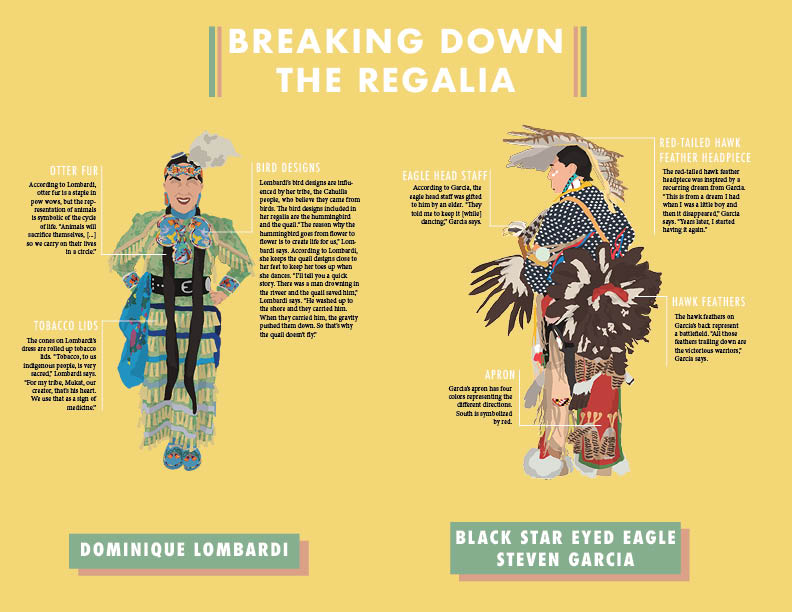When Black Star Eyed Eagle Steven Garcia was a kid, he had a recurring dream about a red-tailed hawk.
It wasn’t until the Tongva native was well into his 30s when he dreamt of the bird again. Two weeks later, he received two sets of red-tail feathers from two different people and found smaller feathers on a hike, which would later be a focal point of his dance regalia. His headpiece was complete.
Garcia wore this personalized headpiece at the 49th annual Long Beach Pow Wow. Participants’ attire varied in colors and pieces depended on their affiliated style of dance, tribe and personal preference.
Head woman dancer Dominique Lombardi wore a jingle dress during her medicine dance routine, adopted from the Anishinaabe and Ojibwe people. Tobacco cone lids jingled with each side step movement, signifying the sound of rain for purification.
As a native of the Cahuilla tribe in the Morongo reservation, Lombardi adorned the tobacco lids to honor the creator of her people.
“Tobacco to us indigenous people is very sacred,” Lombardi said. “For my tribe, tobacco is known as our Mukat, our creator, that’s his heart. We use that as a sign of medicine.”
Dancers like Lombardi have a lot of items stitched and tied to their clothing. But accumulating the items necessary for the regalia takes time. From beading moccasins to gathering feathers, the process of making handmade outfits is a community effort.
Osteen Bob, a southern style dancer of the Navajo people, has been crafting his attire for over 20 years, picking apart and adding new pieces along the way.
“I’ve been doing this since I was 2,” Bob said. “I’m 29 now … Throughout the years, I started getting older, so I [had to] make things bigger.”
Enlarge

Graphics based on attire worn by Dominique Lombardi (left) and Black Star Eyed Eagle Steven Garcia (right).
Graphics by Miguel Martinez
Many times, pieces of an outfit are acquired as gifts from elders. Carlos Miranda, a 14-year-old northern traditional old style dancer, was bestowed his aprons, feathers and bells from his mentor. His moccasin boots, tied with jingling bells, played a mellow-paced tune with every step, akin to his style of dance.
“[My shoes] are traditional style footwear,” Miranda said. “I started out with a black pair of Nikes. And then my dad actually got these [boots] for me, so I can actually fully dance.”
Gavin Watts, a boy scout and sophomore from Los Alamitos high school, received his bald eagle feather headpiece from an elder in the Cheyenne tribe. Experiences like these are necessary to the intergenerational community aspect of the tribe. Often times, the older generation will gift items to a younger dancer to use in a style of dance.
“It’s like when I see a kid doing really well and see a style of dancing, if I [have] something he can use, I just give it to him,” Garcia said. “A lot of times [people tell me], ‘Oh you can sell that,’ but that’s not what it’s about.”
Bird feathers, otter fur and porcupine roaches were common items donned by Pow Wow participants. Despite the difference in regalia based on dance styles, the presence of animals was apparent in the outfits worn by the dancers to symbolize the circular ongoings of life.
“Animals will sacrifice themselves … so we carry on their lives in a circle,” said Head Woman Dancer Dominique Lombardi.
Much of the animals stitched, beaded or placed on the attire were representative of the dancers’ tribe. Native from the Cahuilla tribe in the Morongo reservation, Lombardi based her turquoise jingle dress on her people, who believe they came from birds. She donned a beaded hummingbird and quail on her outfit, with the blue base representing the sky.
Stitched on Bob’s apron was a traditional waterbird to symbolize his people’s church. On the back of his regalia, he wore golden eagle feathers as a sign of his style of southern dancing.
“Swimmers, crawlers, fliers, you name it, they’re all sacred because we all take turns,” Garcia said. “When I’m laid out in the ground and become dirt, the animals will be living on me. We all trade places.”




